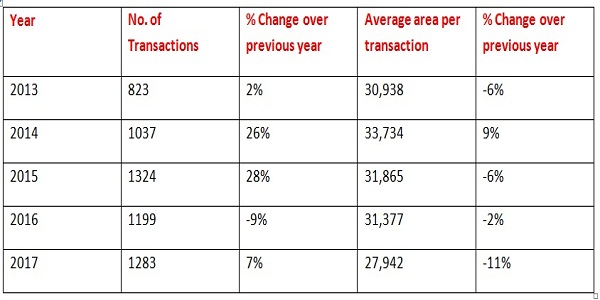-
UNION INTERIM BUDGET 2024-25 -
-
Are cryptocurrencies the future of the digital world economy -
-
Breaking Waves, Breaking News: Lakshadweep’s Recent Developments Explored -
-
The Impact of the Digital Economy on Business and Society -
-
Augmented Marketing: A Comprehensive Guide -
-
How To Strengthen Your Email Marketing Using AI -
-
How Artificial Intelligence and Digitization Are Transforming Our Lives -
-
What Data Science Tools do the Experts Recommend? -
-
Robotic Process Automation Will Transform Your Business? Check Here! -
-
Edge Computing: How it is Reshaping Cloud Infrastructure -
Number of office leasing transactions increase by 60% in 5 years: JLL India study
Mumbai: JLL, India’s largest real estate services firm, in their latest study note that there is a remarkable increase in the number of office leasing transactions over the last 5 years (2013 – 2017). While only about 820 lease transactions (in Grade A buildings only), recorded by JLL in 2013, the number reached close to 1300 lease transactions (recorded by JLL) in 2017.
This said the study showed a decline in the average size of transactions from close to 32,000 sf in 2013 /14 to 28,000 sf in 2017. This is broadly understood to be the result of companies exercising workplace rationalization and consolidations.
The report noted that a change in trend in the office space dynamics noting that the total number of office space transaction has seen an upward movement in the last 5 years (2013 – 17) in the top eight cities of India.
As a result of which, the recorded number of transactions in 2017 was close to 1300 resulting in the net leasing of approximately 29 msf. The total numbers of transactions were close to 60% more when compared to 2013 and were about 7% year on year over 2016.
The big jump was however seen in the periods of 2014 and 2015 which was largely due to the stability brought in by the then newly elected government that had come to power with a clear majority.

The average sizes of the transactions have however seen a decline in the same period. The size per transaction has moved down from an average of 31,000 sf in 2013 to 27,000 sf 2017. This is significant as this defines the way office space is actually getting consumed.
Given the fact that IT/ ITeS remains the majority consumer of office space in India contributing close to 40% of all office leasing transaction, this decline signals a trend of rationalisation of space uptake, through consolidation and workplace strategy implementations. We also saw the rise of additional sectors like e-commerce and co-working in the last few quarters. These two segments have radically changed the concept of office space utilisation.
There is a serious consideration towards creating flexible workspaces and new age collaborative space. One of the key drivers of the surge in corporate demand for flexible spaces identifies the report, is plug-and-play simplicity, particularly for larger companies. The ability to move in and out of an office at short notice, avoid complicated contract negotiations and fit-out work is a convenient option for many occupiers.
Ramesh Nair, CEO and Country Head, JLL India said, “Indian office transaction is at an interesting cusp. We have been experiencing a growth in overall leasing activities. While net absorption have remained stable for the last few years, we expect it to be at approximate 32 million square feet (msf) by end of 2018 and be close to 35 msf in the subsequent two years till the end of 2020.”
Ramesh further added, “Over the next few years, we can expect to see the pie for co-working and flexible office space increase, while IT/ ITeS will remain the largest leasing group. Other sectors impacting the office absorption for the next three years are will be e-Commerce and related businesses, BFSI and FinTech companies and business consulting and services firms.”































